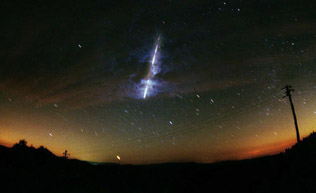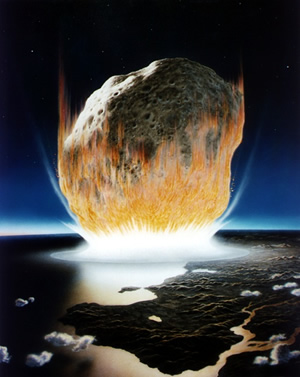Geologists have discovered a new way of estimating the size of impacts from meteorites.
Courtesy of NASA
Geologists Discover New Way of Estimating Size and Frequency of the Impacts of Meteorites
News story originally written on April 11, 2008
Scientists have developed a new way of determining the size and frequency of meteorites that have collided with Earth. Meteorites contain a rare element called osmium, and they have different levels of this element than the levels normally seen in the oceans on Earth. When a meteorite hits the Earth, the osmium is released where the meteorite landed. If it lands in the ocean, the osmium mixes in the ocean very quickly. Eventually these new levels of osmium settle into deep-sea sediments. Scientists can collect samples of the sediments many years later and learn about the meteorites that hit the Earth in the past.
By studying deep-sea sediments, scientists have learned that the size of the meteorite that likely plummeted to Earth at the time of the Cretaceous-Tertiary (K-T) boundary 65 million years ago was four to six kilometers across. The meteorite was the trigger, scientists believe, for the mass extinction of dinosaurs and other life forms.
One of the scientists involved in this study,
François Paquay, said that this new technique will allow scientists to learn more about many other meteorites that have hit the Earth.
You might also be interested in:

Meteors are streaks of light, usually lasting just a few seconds, which people occasionally see in the night sky. They are sometimes called "shooting stars" or "falling stars", though they are not stars
...more
Scientists have learned that Mount Hood, Oregon's tallest mountain, has erupted in the past due to the mixing of two different types of magma. "The data will help give us a better road map to what a future
...more
The Earth's mantle is a rocky, solid shell that is between the Earth's crust and the outer core, and makes up about 84 percent of the Earth's volume. The mantle is made up of many distinct portions or
...more
Some geologic faults that appear strong and stable, slip and slide like weak faults, causing earthquakes. Scientists have been looking at one of these faults in a new way to figure out why. In theory,
...more
The sun goes through cycles that last approximately 11 years. These solar cycle include phases with more magnetic activity, sunspots, and solar flares. They also include phases with less activity. The
...more
Studying tree rings doesn't only tell us the age of that tree. Tree rings also show what climate was like for each year of a tree's life, which means they can tell us about climates of the past and about
...more
Earth's first life form may have developed between the layers of a chunk of mica sitting like a multilayered sandwich in primordial waters, according to a new hypothesis. The mica hypothesis, which was
...more















